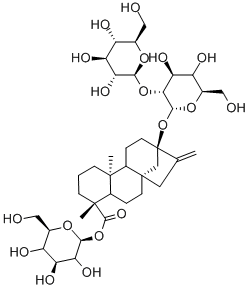
Product name:Stevioside
CAS:57817-89-7
Molecular Formula:C38H60O18
Formula Weight:804.87
Specification:20mg
Description:
The Stevioside are responsible for the sweet taste of the leaves of the stevia plant (Stevia rebaudiana Bertoni). These compounds range in sweetness from 40 to 300 times sweeter than sucrose. They are heat-stable, pH-stable, and do not ferment.They also do not induce a glycemic response when ingested, making them attractive as natural sweeteners to diabetics and others on carbohydrate-controlled diets.
Stevioside is a perennial herb of stevia genus, compositae. It is a valuable sugar crop that originated in the amanbai mountains of South America on the border of Paraguay and Brazil. China has introduced and cultivated it. The whole plant contains sugar, and the leaves are the sweetest. Contains 14% stevia glycoside, the branches of the glycoside equivalent to half of the leaves. Leaves can be dried and crushed as sugar, or after heat alcohol treatment, ethyl ether precipitation can also obtain 20 ~ 26% egg yellow crude extract, sweetness is 100 ~ 150 times of white sugar, white products, sweetness is 250 ~ 300 times of white sugar, and heat is only 1/300 of white sugar. Stevioside has six monomeric substances, white powdered diterpene glycoside has been proposed, the sweetness of sucrose is 300 times; Diterpene alcohol glycoside; Ribosside A is 450 times sweeter than sucrose. Ribosside B; Glycyrrhizin A and glycyrrhizin B can be used as sweet additives.
Stevioside likes temperature and humidity and is not strict with soil. Stevioside grows well when the soil is moist, the fertilizer is sufficient, and the temperature is above 15℃. The root system consumes little oxygen, is resistant to high humidity, and is not resistant to drought, and its growth is inhibited in early water shortage. Little nutrients were absorbed at the early stage of growth, and the most was absorbed at the flourishing stage. Among nitrogen, phosphorus and potassium, the most was absorbed, and phosphorus was less. Nitrogen was moderate. It is appropriate to harvest at the beginning of the season when the glycosides and monosaccharide stevia glycosides are most abundant.
Stevia used to be wild and cross-pollinated. After years of introduction and domestication, its descendants are widely separated with a large range of variation. In the mixed lines, there are big leaves, small leaves, thick leaves, thin leaves, late ripening, early maturing, disease resistance, disease resistance, drought resistance, drought resistance and other types.

